
How to climb Mount Fuji and have fun? Is it even possible? Well, if the most epic journey to Japan’s highest peak isn’t fun, you probably aren’t doing it right;) Climbing Mount Fuji is obviously challenging, but good preparation will make it a lot easier and more fun!
I have recently climbed Mount Fuji three times and in this blog post, I share all the tips based on my climbing experience. You will learn how to prepare for the climb, which trail you should choose, what to pack and what to expect. Let your Mount Fuji climb be fun and let’s get started!
2024 UPDATE – NEW RESTRICTIONS & NO BULLET-CLIMBING!
The total number of climbers on Mount Fuji has almost returned to very high pre-pandemic levels (221,000 in 2023 compared to 235,000 in 2019). As before, over 60% of climbers used the Yoshida trail, which is why, starting in 2024 new restrictions will be implemented at the most popular Yoshida Trail to limit the crowds:
- Daily limit of 4,000 hikers;
- An additional charge of JPY 2,000 (on top of the regular JPY 1,000 fee charged on all trails).
Returning crowds and an extra fee are additional reasons to choose the less travelled routes.
Additionally, all four Mount Fuji trails will be closed from 4pm to 3am for hikers without reservations at the mountain huts. This is to prevent bullet-climbing, which is hiking at night with the intention of reaching the summit by sunrise without staying in a hut. Only hikers staying at huts will be able to climb Mount Fuji at night in order to see the famous sunrise from the summit.
What's in this blog post?
HOW TO CLIMB MOUNT FUJI AND HAVE FUN?
Mount Fuji climbing season
Mount Fuji’s climbing season lasts only two months, from July to September. All mountain huts are then open, so most people decide on the most convenient 2D/1N trekking option.
An overnight stay below the summit allows you to ascend in the morning to see the famous sunrise from the top of Mount Fuji. If you are both in good shape and have some mountain experience, you can also consider a one-day climb, the so-called “bullet climb” which, however, due to its high altitude and the associated fatigue and the risk of altitude sickness, is not recommended.
Climbing Mount Fuji outside the regular season (in spring or autumn) should be planned with a guide. More details on how to climb Mount Fuji in the off-season:
Mount Fuji off-season climb in one day – How to do it right?
The Okumiya shrine at the summit of Mount Fuji in May & in August
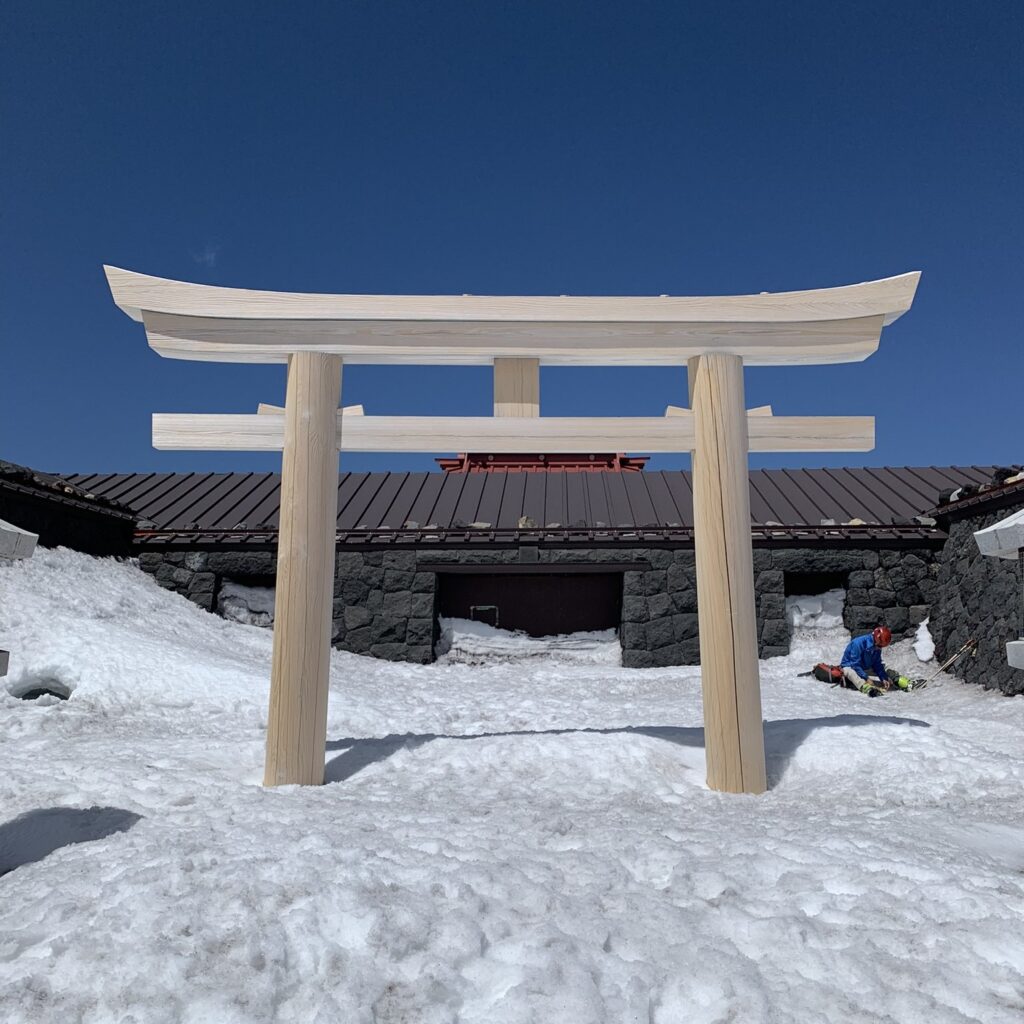
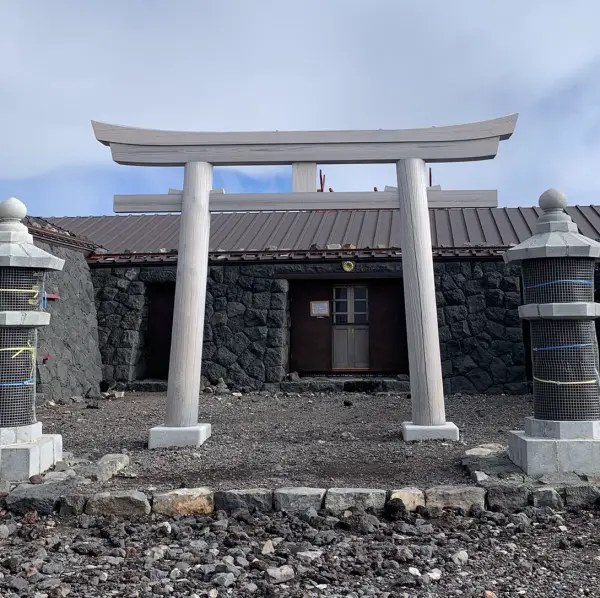
Choose the right route: trails description & comparison
There are four routes leading to the summit of Mount Fuji (3,776 m). Japan’s highest mountain is divided into 10 stations, and the most popular climbing variant assumes starting the climb at the 5th station. Such ascent takes 5 to 10 hours (without rest breaks) depending on the chosen trail and, of course, your pace. Each trail offers a slightly different climbing experience and landscapes, so take some time to read about the trails before choosing your route.
(Rotate the screen for landscape mode to see the full table with details of all four trails.)
| Trail Name | Yoshida | Gotemba | Fujinomiya | Subashiri |
| 5th station (trailhead) altitude | 2,300m | 1,450m | 2,400m | 2,000 |
| Ascent time | 6-7h | 7-10h | 5-7h | 6-8h |
| Descent time | 4-5h | 3-4h | 2-4h | 3-5h |
| Main characteristics | Most popular & developed | Great for descending | The shortest & steepest |
The highest tree line |
| Number of mountain huts | 18 | 4 | 8 | 8 |

Below you will find three bullet points describing each route: a brief description of the trail, who should take this trail and my personal experience with the trail.
Yoshida Trail (yellow)
- The traditional route of pilgrims climbing Mount Fuji for centuries, the most popular, and therefore the most crowded. The easiest access to the trailhead from Tokyo and many mountain huts along the way. The sunrise can be seen from the trail, so if you don’t make it to the summit in time, you can see it on the way.
- The most convenient option, especially for those with less mountain experience. Try to plan your hike on the weekdays as the route is terribly crowded on weekends. Booking accommodation in advance is necessary.
- I climbed the Yoshida Trail in August and enjoyed its extensive facilities as well as people watching. If you love hiking and have a little more time, instead of the 5th station, you can start from the very foot of Mount Fuji, from the ancient shrine, where pilgrims used to begin their journey and where I also started.
Sunrise from the Yoshida Trail

Gotemba Trail (green)
- The longest trail and the least crowded route to the summit. The Gotemba 5th Station located at 1,450m, is the lowest of all four 5th stations. The route passes through the gentle slopes of volcanic gravel.
- If you have enough time and want to avoid the crowds, it is the right option for you. Since there are no huts or toilets until the 7th station, I would not recommend it to beginner hikers.
- Going down the Gotemba trail guarantees lots of fun and anyone can do it! I went down this trail in August and it was awesome. The terrain made of gravel is fantastic for running down, so it is very easy to descend very quickly.
My story how to climb Mount Fuji from the bottom via the Yoshida Trail and descend the Gotemba Trail: HERE
Going down the Gotemba Trail
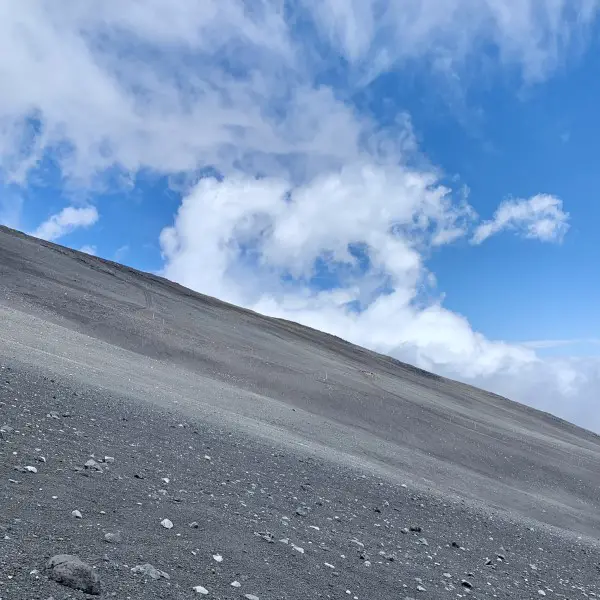
Fujinomiya Trail (blue)
- The shortest and steepest trail with easy access from the western part of Japan (Osaka, Kyoto). The 5th station (2,400m) is the second most popular and second most developed in terms of infrastructure
- Recommended for those who have limited time and/or enjoy physical challenges.
- I used the Fujinomiya trail in the off-season. More details on how to climb Mount Fuji in one day: Mount Fuji off season climb in one day. How to do it right?
The Fujinomiya Trail in May - with snow!
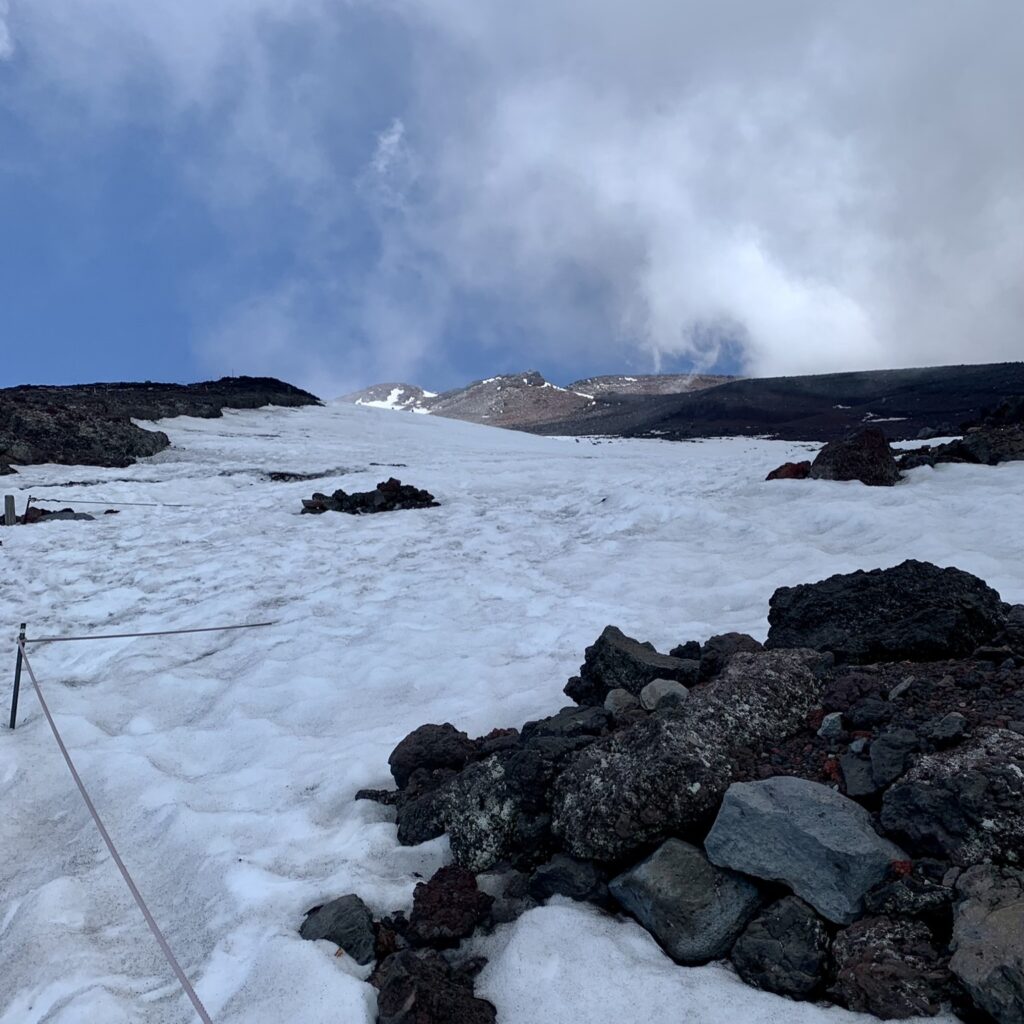
Subashiri Trail (red)
- The initial section of the trail leads through the tranquil forest, which is great on a sunny day.
- The trail is not busy until it joins the Yoshida Trail at the 8th Station, when it gets more crowded. For me, it strikes a perfect balance as initially you can enjoy hiking experience in nature and witness the uniqueness of Mount Fuji climbing and its roaming crowds.
- Recommended for people with some hiking experience (it is longer than the Yoshida Trail), who want to enjoy nature and avoid crowds.
And if you have other questions about Mount Fuji trails but not only, check out my latest article here: 100 THINGS ABOUT CLIMBING MOUNT FUJI I promise that it has all the answers 🙂
More tranquil Subashiri Trail

10 TIPS TO MAKE YOUR CLIMB EASIER
I read a lot of about Mount Fuji climb, how tough and cold it is. I also saw with my own eyes many miserable hikers, completely unprepared to climb the almost 4,000m mountain. So how to climb Mount Fuji and have fun? Follow my tips to make your climbing experience easier and more enjoyable, make it fun! 🙂
Good preparation and gear (no sandals with socks please) will help you to enjoy the climb when it gets cold & wet 🙂

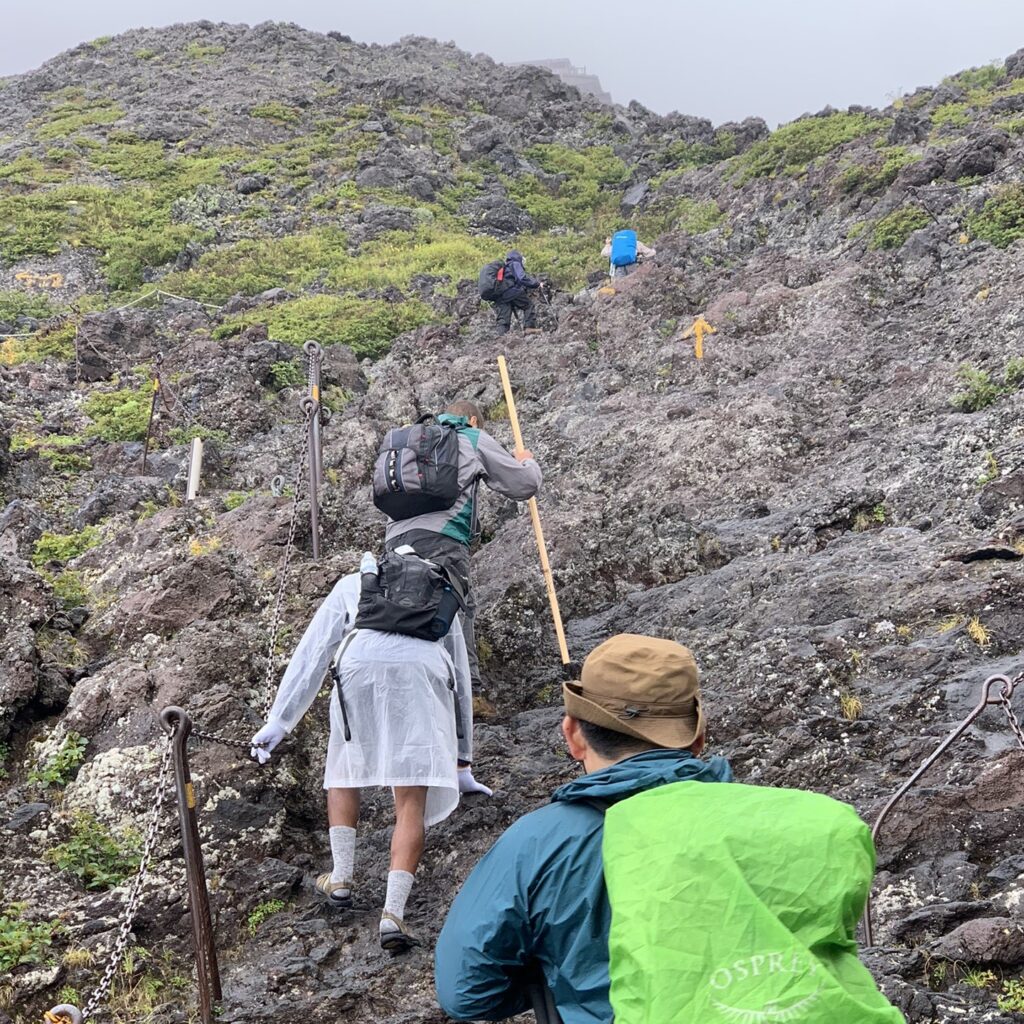
1. Train for the climb
You can do plenty of things to train for Mount Fuji climb: hike in the mountains, go for long walks or jogging, do some aerobic workout. However, my favourite exercise, the easiest and unfortunately not very enjoyable, is climbing stairs. It helps to strengthen your leg muscles, builds strength and stamina. It is perfect training for hiking any mountain and everyone can do it, as stairs are everywhere!
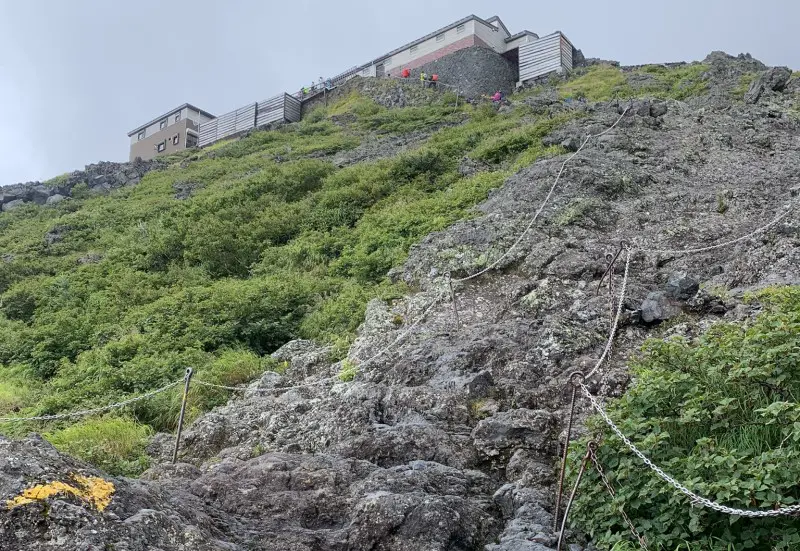
2. Dress in layers and bring warm clothes
It will be very cold at the top, especially if you are planning a sunrise hike. I wore the same layers as during the coldest moments on my treks in the Himalayas (down jacket, fleece, merino wool thermal layers (top and bottom) and a pair of leggings) when I set off from the 8th station at 2.40 am for sunrise. I was warm at the top, while plenty of people around me, instead of enjoying the incredible sunrise, were trembling with cold. You will find a complete packing list below.
3. Good waterproof gear
The weather on Mount Fuji is unpredictable and the winds can be very strong. I have experienced all kinds of weather – sun, fog and rain. If you don’t have a rain jacket, buy a raincoat. I saw so many people suffering because of the pouring rain, please don’t be one of them.

4. Hiking shoes
The terrain is uneven and rocky. If you are going to the summit for sunrise, it will also be cold. Hiking shoes are definitely the best choice. Don’t allow wet feet to spoil this beautiful adventure. If you wear sneakers, you can try to protect your feet the Nepalese way: put a plastic bag between two pairs of socks. Your shoes will be wet, but your feet will not 🙂

5. Start your adventure early
If you take a morning bus from Tokyo, there might be delays as traffic jams occur often, especially on weekends. Besides, the ascent is long, so in order not to worry about getting dark or the deteriorating weather, try to start your hike as early as possible.
6. Climb slowly and drink plenty of water to avoid mountain sickness
Starting early will allow you to climb slowly, which is the best way to prevent altitude sickness symptoms. Due to the lower amount of oxygen in the air, some people may begin to experience some altitude sickness symptoms (headache/ dizziness) above 3000m. Taking breaks and drinking plenty of water are the most effective methods to acclimatise. Canned oxygen is available on the trail. I didn’t buy it, so I’m not sure how it works but I saw some people using it.
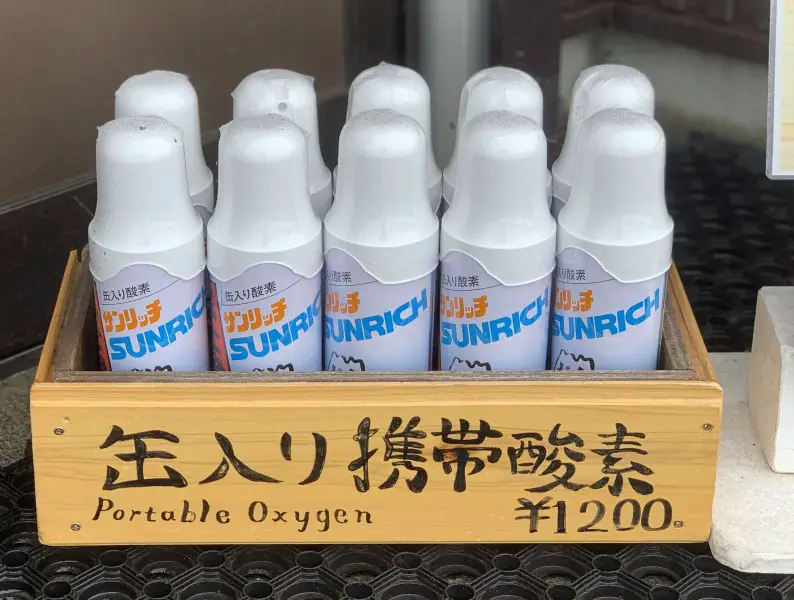
7. Book the mountain hut at higher altitude and do it in advance
The higher you spend the night, the less you will climb in the dark the next day (if you plan to see the sunrise). I stayed at the 8th station (Ganso-Muro at 3,250m) and it took me 2 hrs to reach the summit in the morning. To do that I still needed to wake up at 2am… The path trail above the 8th Station gets crowded, especially the Yoshida trail before the sunrise. Even normally fast hikers go slowly as overtaking is not possible. Besides, if you stay higher and the weather is fine, you have a better chance for a beautiful sunset view from the mountain hut.
Booking Mount Fuji huts is usually possible from May. If you plan climbing on the weekend and wish to stay at the 8th station or above – book your spot early as huts tend to be booked out very quickly.
Check out this complete guide how to book Mount Fuji hut for more details:
BOOKING MOUNT FUJI MOUNTAIN HUT – LIST OF HUTS ON ALL TRAILS
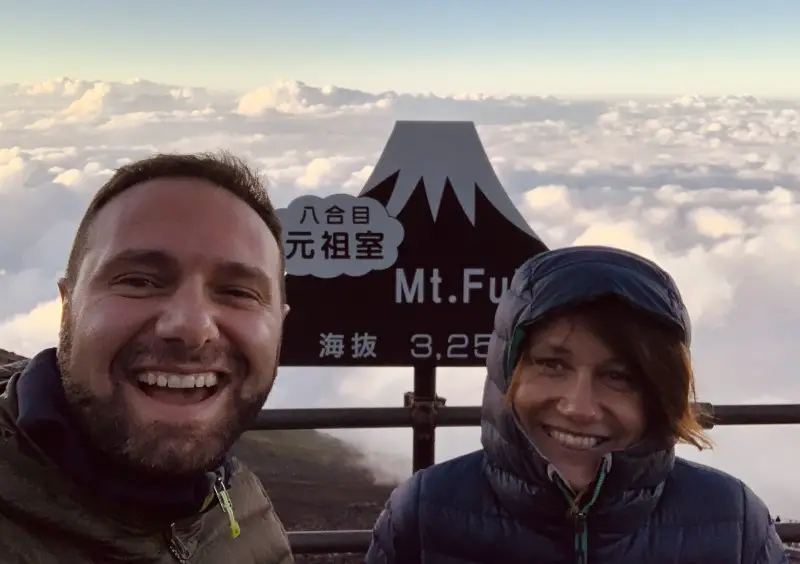
8. Choose the right trail
As already mentioned, there are four different routes to Mount Fuji. Read about what they offer and choose the one that suits you best. Don’t complain about the crowds if you choose the Yoshida Trail.
9. Make your descend easy and go down the Gotemba Trail
Descending Mount Fuji is the worst part of the climb according to many people. You are usually tired, the excitement is gone, your knees hurt. However, it does not have to be that way. Going down the Gotemba Trail was probably my favorite part of the climb. Running down the volcanic gravel among the lunar landscape was so much fun! It was also easier for my poor knees, and so quick! Thrilling experience and convenience at the same time – fantastic! Read more about “The Great Sand Run”: HERE.
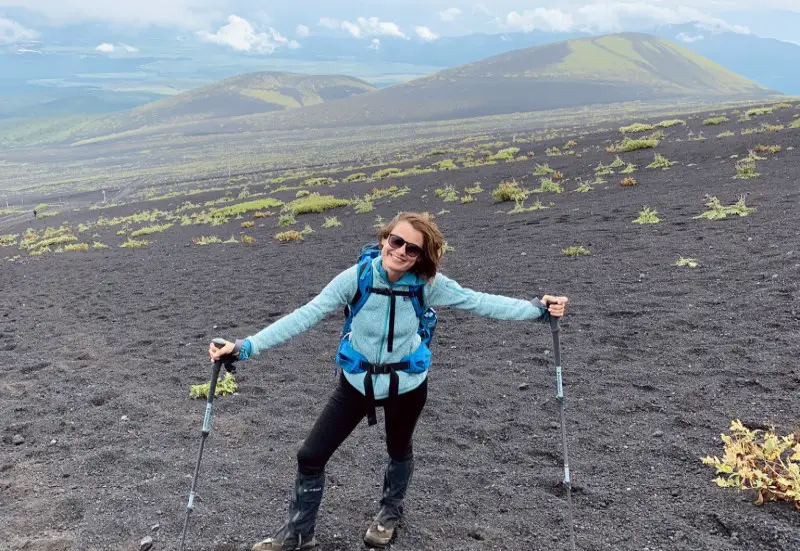
10. Relax after your climb the Japanese way
Climbing Japan’s most sacred mountain, which has attracted climbers since the 7th century, is not only an amazing mountain adventure but a great cultural experience as well. To continue your truly Japanese experience in a traditional way, head to the onsen (Japanese hot springs) to relax your muscles after the climb.

A COMPLETE PACKING LIST FOR CLIMBING MOUNT FUJI
How to climb Mount Fuji and have fun? It’s simple – you have to bring everything you need on the mountain to feel warm and safe. Packing is undoubtedly the most important part of your preparations. Here is a complete packing list:
Backpack (30L-40L) with the rain cover – Pack all your items in plastic bags for extra rain protection.
Hiking shoes
2 pairs of hiking socks – One for the night or in case the other pair gets wet.
Trekking poles – To protect the knees when descending steep slopes and improve balance in uneven terrain. In case you don’t have them, you can buy the Mount Fuji wooden walking stick on the trail. This incredibly popular souvenir will do a similar job.
Warm jacket
Rain wear – Jacket and pants/ raincoat, gaiters
A set of thermal underwear & t-shirt
Fleece and hiking pants/leggings – Don’t wear jeans. When they get wet, they are very uncomfortable.
Headlamp – Crucial for a sunrise hike as it will be dark. Using your phone’s torch is never a wise idea in the mountains. You need to have both your hands free and a charged battery in your phone.
Wet tissues – There are no showers on the trails.
Water & snacks – They are more expensive on the trail. Also, you need to have some snacks for the sections between mountain huts – especially if you don’t ascend the Yoshida Trail.
Mask and earplugs for sleeping – Mountain huts dorms are big and always crowded.
Plastic bags for your rubbish as you need to bring everything down.
Powerbank – You might not be able to charge your phone in the mountain hut.
100 JPY coins for paid toilets, which can cost up to 200-300 JPY

MOUNT FUJI CLIMBING EXPERIENCE: WHAT SHOULD YOU EXPECT?
Climbing Mount Fuji is an incredibly unique experience. You can experience both various dramatic landscapes and high altitude climbing in a very short time and extremely accessible way. For centuries, people have climbed Japan’s most sacred mountain, a source of inspiration and national pride, the most beloved and highest peak. This all means that it will definitely be a one-of-a-kind experience, which can’t be compared to anything else.
But as with every very popular tourist spot or strenuous mountain climbing experience you need to manage your expectations well. Before the pandemic, 300,000 people a year climbed Mount Fuji in the regular season – in just two months! You won’t probably find your inner peace during the climb, especially if you take the Yoshida Trail. It will be very crowded.
The famous sunrise at the top of Mount Fuji attracts crowds of hikers
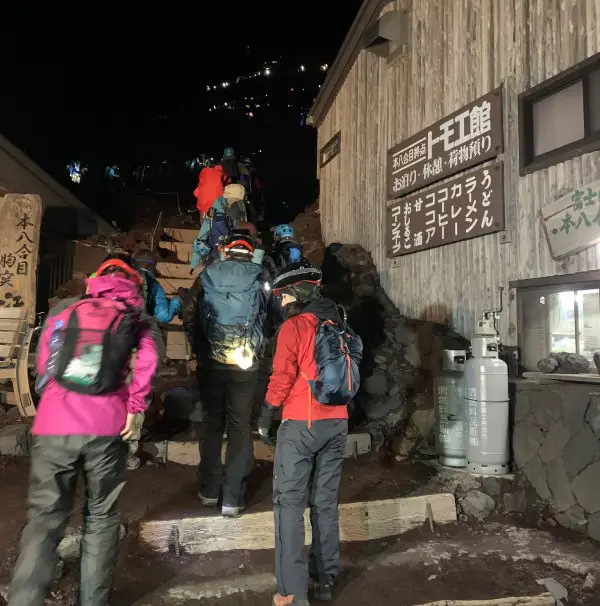
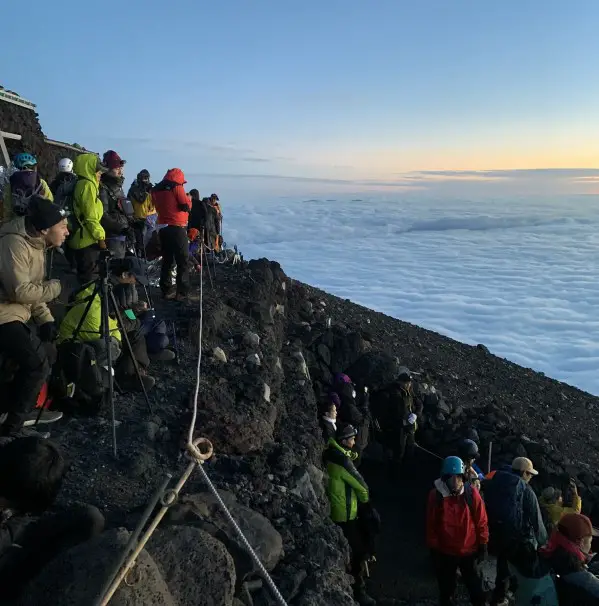
Moreover, Mount Fuji rises up to almost 4,000 metres, so especially if you climb for the sunrise, it will be very cold on the top. These are two of the most obvious and least enjoyable aspects of the climb, but there are a few other things you should be aware of.
It was 30C in Tokyo when we stood on the top of Mount...

Changes in Mount Fuji climbing rules after the pandemic
The mountain huts capacity has been reduced
I have heard crazy stories of three people, often complete strangers, sleeping on one futon mattress before the pandemic. Sleeping was not really possible in such circumstances. Currently, everyone gets their own mattress. What’s more, wooden dividers are placed between people, so you can get a bit of privacy and comfort even in large and usually crowded dormitories. This is definitely a change for the better.
On the flip side, mountain huts have always been booked out very quickly. In 2023, the accommodation capacity of Mount Fuji huts was reduced to about a half or a third of their regular capacity before the COVID-19 pandemic.
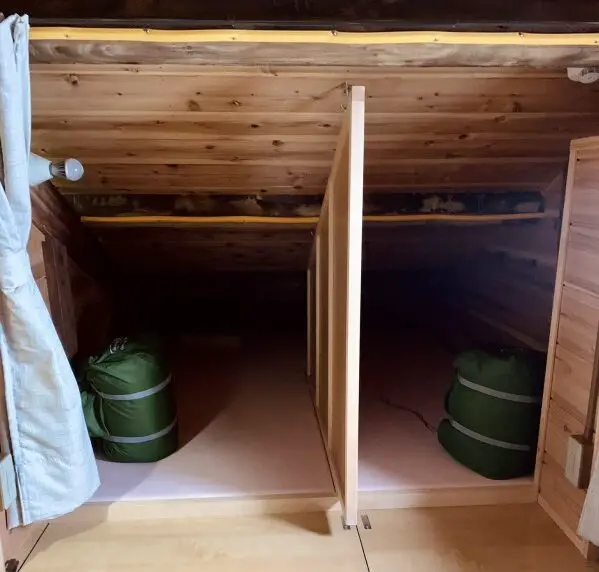

You cannot take a rest inside the mountain hut without reservation
If you do not have a booking for a night, you can’t rest in the mountain hut during the day. You can still order a drink or some food from every hut, but you have to consume it outside the building. In good weather it is not a big deal but… when you’re cold and wet, you’re tired and you have a few more hours to climb, drinking tea in the rain isn’t very pleasant.
This rule, implemented to prevent the spread of the coronavirus, seems a bit controversial because hotels, restaurants and bars in Japan no longer have such regulations, you can always eat or drink inside. Hopefully this is just a temporary restriction that will no longer apply in 2023.
UPDATE 2023: Apparently due to the very limited space, you simply won’t be let inside the hut without reservation. However, compared to last year, when I saw numerous notes stuck to the door clearly stating “no entry due to the spread of the COVID-19 virus”, the overall atmosphere in the huts felt more inviting.
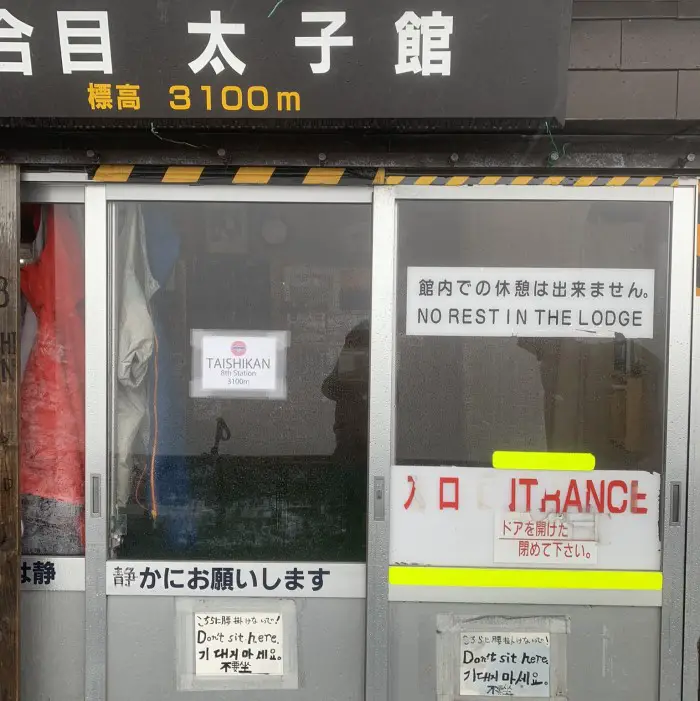
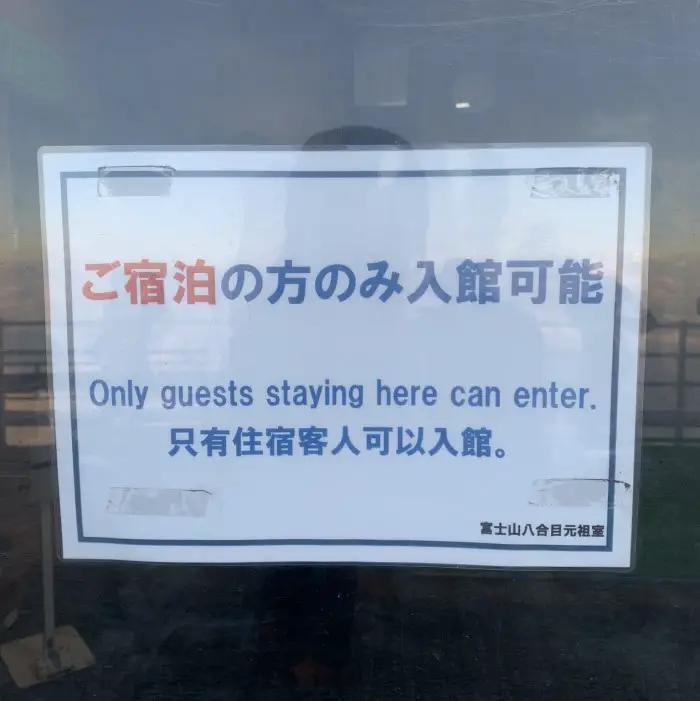
The less positive sides of climbing Mount Fuji
The problem of plastic
There are no water dispensers in the mountain huts on the trails. Of course, I don’t expect free water. On the contrary I know that its price at high altitude is higher to include additional transport costs. Unfortunately, when climbing Mount Fuji, if you want a drink, you have to buy water in a plastic bottle, as there is no other option. The plastic problem in Japan is greater, it affects the entire country, not just the slopes of Mount Fuji. Up there in the wild, it only becomes even more apparent and more annoying.

Commercialisation of Japan’s most sacred mountain
I love sitting with a cup of hot tea inside a cosy mountain hut, which is run by mountain lovers like me. The relaxing atmosphere makes it easy to share your own stories and make new friends. Even the most simple meal tastes better. Unfortunately, while climbing Mount Fuji, this feeling of warm hospitality and soothing atmosphere at the table was missing. In crowded mountain shelters, there seems to be no room for that.
Despite those few less enjoyable sides of Mount Fuji climbing experience, both times I climbed it, I loved it. Reaching the summit of Japan’s most sacred mountain, one of the world’s most iconic peaks, is both an incredible hiking adventure and a unique cultural experience. So prepare well and have fun! 🙂
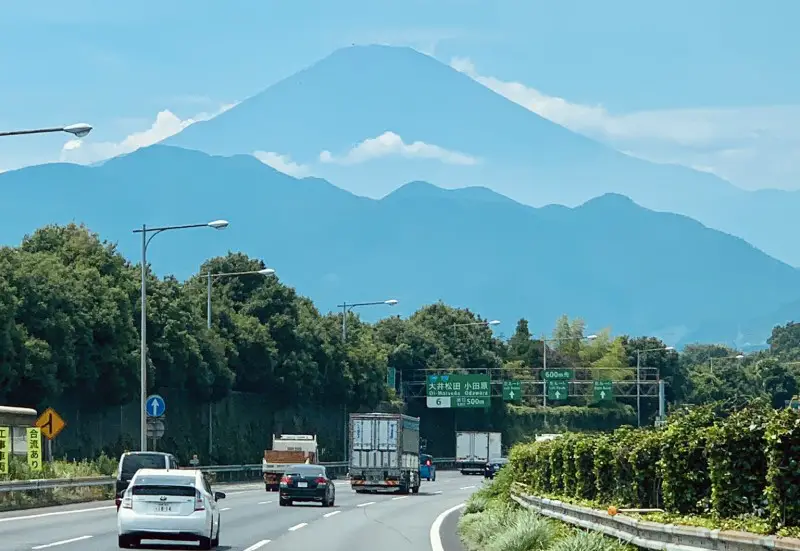







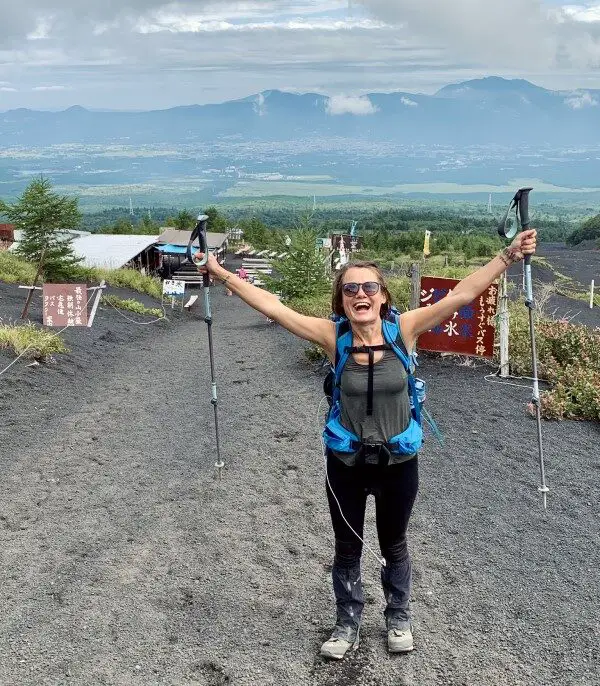
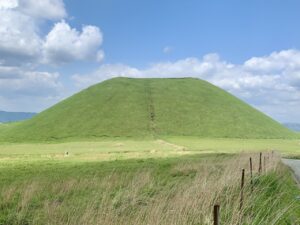
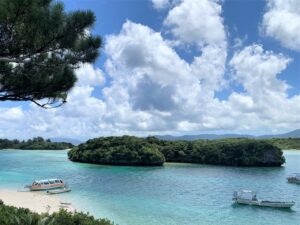

Hi Beti
Thank you for all this fantastic information. I am looking for a raincoat like you are wearing, what is the brand please? I am booked with FMG late august, so nervous and excited!! Thank Elizabeth
Hi Elisabeth, thank you for reading my blog! My raincoat has no brand 🙂 I bought it cheaply in Nepal, but it’s quite thick and resistant. Sorry, I don’t think it helps you at all. But as long as you buy a raincoat in an outdoor store before your trek, and not a very thin and cheap available on the trail or in convenience stores, you should be ok! Enjoy your adventure! It’s going to be awesome!